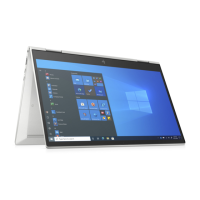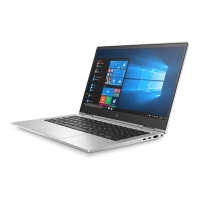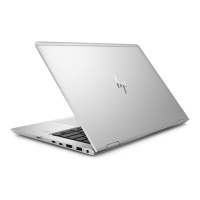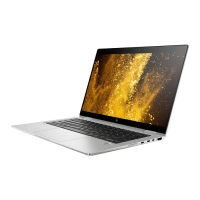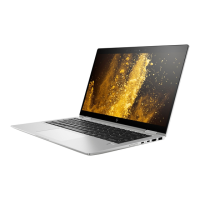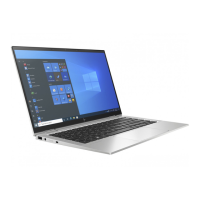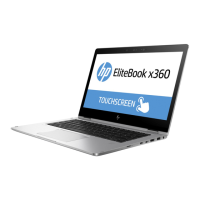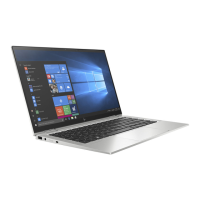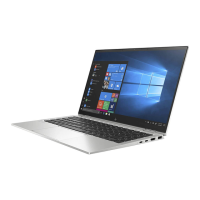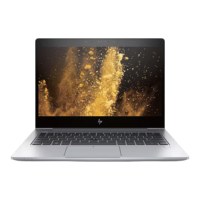Do you have a question about the HP EliteBook x360 830 G8 and is the answer not in the manual?
Identifies and describes components located on the right side of the computer.
Identifies and describes components located on the left side of the computer.
Details components integrated into the computer's display panel.
Covers keyboard layout, touchpad, lights, buttons, and special keys.
Identifies components located on the underside of the computer.
Explains the purpose and location of computer labels for identification.
Lists and illustrates the main components of the computer with their part numbers.
Details the parts included in the Bracket Kit, Plastics Kit, and Cable Kit.
Lists various miscellaneous parts and their corresponding spare part numbers.
Lists the specific tools needed to perform component removal and replacement procedures.
Provides essential advice on handling components, screws, and cables during service.
Explains ESD risks and detailed measures to prevent component damage from static electricity.
Details methods for personal grounding and preparing a safe work area to prevent ESD.
Provides instructions for safely cleaning computer surfaces and components.
Offers best practices for packaging and transporting computer equipment to prevent damage.
Essential steps to take before starting the disassembly process.
Procedure for safely removing and replacing the computer's bottom cover.
Instructions for removing and installing the Wireless Local Area Network module.
Instructions for removing and installing the Wireless Wide Area Network module.
Procedure for removing and replacing the M.2 solid-state drive.
Step-by-step guide for removing and installing the computer's battery.
Instructions for removing and disassembling the computer's display assembly.
Procedure for removing and replacing the power connector cable.
Procedure for removing and replacing the fingerprint reader board.
Procedure for removing and replacing the Real-Time Clock battery.
Procedure for removing and replacing the computer's touchpad.
Procedure for removing and replacing the Near Field Communication module.
Instructions for removing and installing the computer's fan assembly.
Procedure for removing and replacing the computer's heat sink.
Procedure for removing and replacing the WWAN antennas.
Detailed steps for removing and installing the computer's system board.
Procedure for removing and replacing the computer's speakers.
Procedure for removing and replacing the computer's card reader board.
Procedure for removing and replacing the keyboard and top cover assembly.
Instructions for accessing and navigating the Computer Setup (BIOS) utility.
Steps to reset system BIOS and configuration settings to factory defaults.
Information on finding, downloading, and installing BIOS updates.
Guide to configuring Trusted Platform Module (TPM) settings in BIOS.
Information on HP Sure Start technology for BIOS protection and recovery.
Procedures for backing up data and creating system recovery media.
Various methods available to restore the computer system.
How to modify the system's boot order through BIOS settings.
Utilizing HP Sure Recover for OS image restoration without external media.
Instructions for using the Windows-based diagnostic utility for hardware testing.
Steps for running hardware diagnostics using the UEFI environment.
Information on configuring and using remote hardware diagnostics.
Lists dimensions, weight, power, and environmental operating specifications.
Details specifications related to the computer's display panel characteristics.
Lists performance and physical specifications for solid-state drives.
Procedures to restore nonvolatile memory and BIOS settings to factory defaults.
Table detailing troubleshooting steps for various nonvolatile memory types.
Answers common queries about BIOS, UEFI, and nonvolatile memory.
Outlines universal power cord requirements, including length and safety standards.
Details power cord certifications and specifications for various countries and regions.
| Color gamut | 72 % |
|---|---|
| RGB color space | NTSC |
| Display diagonal | 13.3 \ |
| Anti-glare screen | Always gives an optimal view, even in direct sunlight. |
| Display brightness | 400 cd/m² |
| Native aspect ratio | 16:9 |
| Display diagonal (metric) | 33.8 cm |
| Processor cache | 8 MB |
| Processor cores | 4 |
| Processor model | i5-1135G7 |
| Processor family | Intel® Core™ i5 |
| Processor threads | 8 |
| Configurable TDP-up | 28 W |
| Processor frequency | 2.4 GHz |
| Processor cache type | L3 |
| Configurable TDP-down | 12 W |
| Processor manufacturer | Intel |
| Processor boost frequency | 4.2 GHz |
| Configurable TDP-down frequency | 0.9 GHz |
| ECC | No |
| Memory slots | 1x SO-DIMM |
| Internal memory | 16 GB |
| Memory clock speed | 3200 MHz |
| Memory form factor | SO-DIMM |
| Internal memory type | DDR4-SDRAM |
| Maximum internal memory | - GB |
| Memory layout (slots x size) | 1 x 16 GB |
| SSD capacity | The Solid State Drive's storage capacity in Gigabytes. |
| SSD interface | PCI Express, NVMe |
| Storage media | SSD |
| Total storage capacity | 512 GB |
| Number of SSDs installed | 1 |
| Battery weight | 213 g |
| Battery capacity | 53 Wh |
| Number of battery cells | 3 |
| Form factor | Convertible (Folder) |
| Product type | Hybrid (2-in-1) |
| Product color | Silver |
| Country of origin | China |
| Market positioning | Premium |
| Pointing device | Clickpad |
| Input device model | Clavier HP Premium |
| Keyboard special features | Étanche |
| Operating system architecture | 64-bit |
| HP segment | Business |
| HP front camera | HP Webcam HD IR |
| HP speaker type | HP Dual Speakers |
| HP Security tools | Absolute persistence module; HP DriveLock and Automatic DriveLock; HP Secure Erase; Power-on authentication; Preboot authentication; TPM 2.0 embedded security chip shipped with Windows 10 (Common Criteria EAL4+ Certied); HP Sure Click; Windows Defender; HP Sure Sense; BIOS Update via Network; Support for chassis padlocks and cable lock devices; HP Sure Start Gen6; HP BIOSphere Gen6; HP Client Security Manager Gen7 |
| HP Management tools | HP Driver Packs; HP System Software Manager (SSM); HP BIOS Cong Utility (BCU); HP Client Catalog; HP Manageability Integration Kit Gen4; HP Client Management Script Library (download) |
| HP Software provided | HP Connection Optimizer; HP Image Assistant; HP Hotkey Support; HP Noise Cancellation Software; HP Support Assistant; Buy Office (Sold separately); HP Power Manager; HP WorkWell; myHP; HP Privacy Settings; HSA Fusion for Commercial; HSA Telemetry for Commercial; Touchpoint Customizer for Commercial; HP Notications; HP QuickDrop; Tile App; HP Wireless Button Drive |
| AC adapter power | 65 W |
| Discrete graphics card model | Not available |
| On-board graphics card model | Intel Iris Xe Graphics |
| Number of built-in speakers | 2 |
| Front camera HD type | HD |
| Front camera signal format | 720p |
| MIMO type | Multi User MIMO |
| Antenna type | 2x2 |
| Bluetooth version | 5.0 |
| Top Wi-Fi standard | Wi-Fi 6 (802.11ax) |
| WLAN controller model | Intel Wi-Fi 6 AX201 |
| Charging port type | USB Type-C |
| USB 2.0 ports quantity | - |
| Depth | 205 mm |
|---|---|
| Width | 307.5 mm |
| Height | 17.9 mm |
| Weight | 1350 g |
